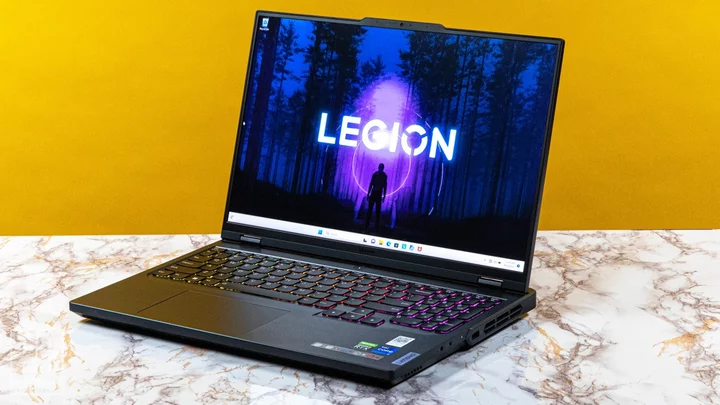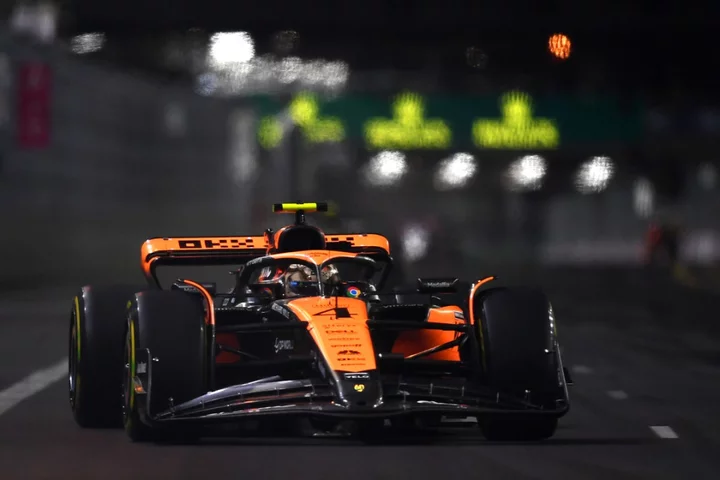It's a tricky thing to balance affordability and performance, and nowhere is that more difficult than in the world of gaming laptops. The midrange Lenovo Legion Pro 5i Gen 8 (starts at $1,179.99, $1,299.99 as tested) is the latest in a long line of solid gaming machines from Lenovo, but while the Legion line has delivered more than its share of top performers and great deals, this one doesn't quite hit the sweet spot. With looks that are nearly identical to those of the premium Lenovo Legion Pro 7i Gen 8, the Pro 5i had us excited for this review, but we came away slightly disappointed by the performance and overall value proposition. Our top budget pick remains the Gigabyte Aorus 15 BMF.
Midrange Configuration Options, Familiar and Functional Design
Base models of the Lenovo Legion Pro 5i Gen 8 cost $1,179.99 with an Intel Core i5-13500HX processor, Nvidia GeForce RTX 4050 graphics, 16GB of memory, and a 512GB solid-state drive. Just one model in a range of configurations, our review unit (at $120 more) stepped up to a Core i7-13700HX CPU (eight Performance cores, eight Efficient cores, 24 threads) and an 8GB GeForce RTX 4060 mobile GPU. You can go wild with a Core i9-13900HX, a GeForce RTX 4070, and up to 64GB of RAM and 4TB of storage; Lenovo doesn't currently offer that config on its website, but we've seen it at retailers for $2,499.
(Credit: Molly Flores)Lenovo keeps its gaming-laptop designs pretty low-key. Sure, there's a shiny chrome Legion logo on the lid and an RGB rainbow of keyboard backlighting, but compared with systems that cram extra bling everywhere they can—adding RGB to the front of the palm rest, the back of the chassis, even across the lid or the touchpad—the reserved look is a nice change. It makes the dark gray laptop one you could carry into an office or classroom without it lighting up like a slot machine when you open it to take notes.
Whether or not you want to haul the Legion around with you is a bigger question. Measuring more than an inch thick and weighing 5.6 pounds, it's a bit much for everyday portability—a common issue with gaming laptops. With aluminum across the lid and chunky plastic making up the rest of the chassis, the Pro 5i is really meant to stay put once your gaming station's set up, though it's not too heavy to take with you occasionally.
(Credit: Molly Flores)The 16-inch display contributes to both the size and weight, but if you aren't worried about portability that's far from a bad thing. The 16:10 aspect ratio gives the notebook a taller profile than past models, like this one's predecessor, the Lenovo Legion 5i Gen 7 from 2022. But while the screen shape may be a bit different, many of the best features of the display remain the same, from the 165Hz refresh rate to the slim bezels surrounding the IPS panel. Nvidia G-Sync leverages the higher refresh rate for exquisitely smooth gaming, and fingerprint smudges on the screen aren't a worry, since touch input isn't supported.
(Credit: Molly Flores)Above the display is a 1080p webcam with an e-shutter to keep things private when you're not in a conference. Other niceties like stereo sound and dual microphones offer good-enough audio for everything from Netflix movies to Zoom calls, but most gamers will still opt for a headset to enjoy immersive 3D audio from the SteelSeries Nahimic sound.
The Port Mix: Capable and Convenient
It's an increasingly common trend in gaming machines to place most of the ports on the back edge of the chassis, which can make for a cleaner setup with a deskbound system connected to monitors and other peripherals. The Legion Pro 5i, in contrast, still has some convenient conductivity along its sides.
(Credit: Molly Flores) (Credit: Molly Flores)On the right you'll find one USB Type-A port, along with an audio jack and physical switch for the webcam shutter. On the left side are both USB-A and USB-C ports, the latter supporting DisplayPort for connecting an external monitor. But the lion's share of connectivity is indeed around back, with everything from more USB-A and USB-C connectors (the latter supporting power delivery) to full-size HDMI and Ethernet ports.
(Credit: Molly Flores)Though it hasn't made the move of switching everything to USB-C, the Legion does seem to omit one or two useful connections such as an SD or microSD card slot or dedicated DisplayPort. But given the industry's push to use USB-C for everything, users of legacy cable and devices will be happy for the ports that are present. It would be nicer if at least one of the USB-C ports met the Thunderbolt 4 spec, but that tends to be a premium perk.
Internally, the Lenovo supports both Bluetooth 5.1 and Wi-Fi 6E for wireless connectivity.
Testing the Legion Pro 5i Gen 8: A Midrange Gaming Melee
In the $1,000-to-$1,500 gaming-laptop segment, there's room for a bit of variety, but not a ton. Most contenders, like today's review unit, feature Intel Core i5 or Core i7 (but not Core i9) processors, GeForce RTX 40 series graphics (but not the flagship RTX 4080 or 4090), and 16GB of RAM plus either 512GB or 1TB of storage. That's the case for everything from the Editors' Choice-award-winning Gigabyte Aorus 15 BMF ($999.99) to the MSI Katana 15 ($1,599 as tested).
Besides those notebooks, we filled out our benchmark comparison charts with the Lenovo Legion Pro 5 Gen 8 (the AMD-powered cousin of our Intel review model) and the HP Victus 16. If you want more graphics or processing muscle, you'll need to climb closer to or over the $2,000 line, and trying to delve below $999 will require cutting serious corners as you start whittling away at CPU and GPU power.
Productivity and Content Creation Tests
We run the same general productivity benchmarks across both mobile and desktop systems. Our first test is UL's PCMark 10, which simulates a variety of real-world productivity and office workflows to measure overall system performance and also includes a storage subtest for the primary drive.
Our other three benchmarks focus on the CPU, using all available cores and threads, to rate a PC's suitability for processor-intensive workloads. Maxon's Cinebench R23 uses that company's Cinema 4D engine to render a complex scene, while Geekbench 5.4 Pro from Primate Labs simulates popular apps ranging from PDF rendering and speech recognition to machine learning. Finally, we use the open-source video transcoder HandBrake 1.4 to convert a 12-minute video clip from 4K to 1080p resolution (lower times are better).
We also run PugetBench for Photoshop by workstation maker Puget Systems, an automated extension to the Creative Cloud version 22 of Adobe's famous image editor that performs a variety of general and GPU-accelerated tasks to rate a PC's performance for content creation and multimedia applications. Unfortunately, you won't see it in the chart below because only the two Lenovos were able to complete the benchmark (the AMD model outscored the Intel, 1,246 points to 949).
Despite its beefy 16-core Intel Core i7 CPU, the Legion Pro 5i fell short of most competitors, bringing up the rear in PCMark 10 and Cinebench and trounced by its AMD counterpart in HandBrake. That said, all five laptops' scores are perfectly acceptable if not exemplary. It's also worth noting that a 1TB rather than 512GB solid-state drive is a big advantage for a gaming laptop; even running our three Steam and Ubisoft gaming benchmarks required some install and uninstall shuffling on the space-strapped Pro 5i.
Graphics and Gaming Tests
For gaming laptops and other mobile gaming hardware, we run both synthetic and real-world gaming benchmarks. The former includes two DirectX 12 gaming simulations from UL's 3DMark, Night Raid (more modest, suitable for systems with integrated graphics) and Time Spy (more demanding, suitable for gaming rigs with discrete GPUs). Also in that mix is the cross-platform GPU benchmark GFXBench 5, which we use to gauge OpenGL performance. These GFXBench tests are rendered offscreen to accommodate different native display resolutions; more frames per second (fps) means higher performance.
Beyond those tests, our real-world gaming testing comes from the in-game benchmarks of F1 2021, Assassin’s Creed Valhalla, and Rainbow Six Siege. These three games—all benchmarked at 1080p resolution—represent simulation, open-world action-adventure, and competitive/esports shooter games, respectively. Valhalla and Siege are run twice (Valhalla at Medium and Ultra quality, Siege at Low and Ultra quality), while F1 2021 is run at Ultra quality settings with and without Nvidia's performance-boosting DLSS anti-aliasing turned on.
Looking over these results, the GeForce RTX 4060 of the Legion Pro 5i is clearly outclassed by the step-up RTX 4070 GPU; no surprise there. The RTX 4070 offers larger core counts across the board, and has a clear edge in all of our gaming benchmarks. The Pro 5i predictably edged the GeForce RTX 4050-equipped HP Victus in most of the tests, but in most cases, it was quite close. If you want to save a buck, the latter delivered nearly the same performance as the RTX 4060 at a lower price.
Battery and Display Tests
We test laptops' battery life by playing a locally stored 720p video file (the open-source Blender movie Tears of Steel) with display brightness at 50% and audio volume at 100%. We make sure the battery is fully charged before the test, with Wi-Fi and keyboard backlighting turned off.
We also use a Datacolor SpyderX Elite monitor calibration sensor and software to measure a laptop screen's color saturation—what percentage of the sRGB, Adobe RGB, and DCI-P3 color gamuts or palettes the display can show—and its 50% and peak brightness in nits (candelas per square meter).
The Legion Pro 5i lasted almost six and a half hours in our video rundown. That's far from the worst we've seen from a gaming laptop—the category isn't made for portability, and battery life takes a backseat to powerful components and cooling—but it's no standout. On the positive side, the Intel-based Legion's display offered impressive color quality and peak brightness, finishing as the most vivid system in the group.
(Credit: Molly Flores)Verdict: A Few Specs Short of Greatness
The midpriced Lenovo Legion Pro 5i Gen 8 follows some of our favorite gaming machines, including last year's model and the higher-end Legion Pro 7i Gen 8 tested earlier this year. But pedigree doesn't count for much in the computer world, and gaming laptops require a certain level of power and graphics performance to justify their prices. The Pro 5i Gen 8 just doesn't do that, offering middling CPU and GPU performance rather than the sort of muscle that would make it a great value. This Legion isn't a bad gaming rig, but if it's a good deal you seek, you might want to wait until it's on sale...preferably with a 1TB drive.









